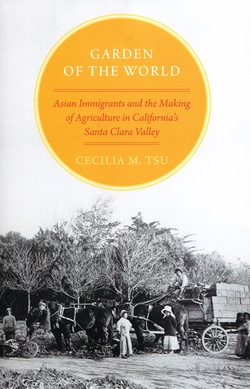As Cecilia Tsu tells readers in her cogent introduction, its underlying purpose is “recovering the intertwined history of the Santa Clara Valley (in California) when it was known as the Garden of the World (1880-1940) along with the history of the Asian immigrants (Chinese, Japanese, and Filipino) who farmed its famed crops,” primarily orchard fruits and berries (p. 13). Clearly, and thankfully, Tsu’s scholarship for her first book did not materialize within a socio-cultural vacuum; rather, it was deeply rooted in and nurtured by her personal, family, and community experience.

When in the 1980s Tsu and her Asian American family moved to the Santa Clara Valley, there existed only vestiges of the Valley’s fabled agricultural past. What drew her family to this then-suburbanizing area, along with many others of Asian ancestry, was the mushrooming of the Santa Clara Valley into a high-tech mecca that became styled as Silicon Valley and rapidly gained international acclaim.
As a child, Tsu assumed the area’s Asians to be newcomers, with no former ties either to the region or to agriculture, who typically found employment with firms like Hewlett-Packard, Intel, and IBM. Thus, confesses Tsu, “I was surprised to discover that…another group of Asian Americans had laid claim to the region as farmers and farm laborers long before the arrival of Asian computer engineers and dot-com entrepreneurs” (p. 13).
About when Cecilia Tsu was making her “discovery,” a then upcoming historian, Gary Okihiro, was on the Santa Clara University faculty. Four years after co-authoring the 1985 book Japanese Legacy: Farming and Community Life in California’s Santa Clara Valley, Okihiro built upon this achievement with the article “Fallow Field: The Rural Dimension of Asian American Studies.” In it he argued that in its preoccupation with transnational, urban, and theoretical pursuits, Asian American studies scholars had left virtually uncultivated the rural Asian American experience.
Responding to Okihiro’s challenge, Tsu goes beyond previous Asian American rural historians by not making her study an ethnic-specific one. While most of her book necessarily focuses on Japanese Americans (the Santa Clara Valley’s dominant Asian group), she both links and compares their variegated agricultural experiences with those of the Chinese American farmers who largely preceded them and the Filipino American farmers who mostly followed in their wake. In the process, she assesses the respective agricultural role of these groups against their stereotypical representation, the white family farm ideal, and white racism, while paying close attention to the inter-ethnic and intra-ethnic divisions instigated by race, gender, and national identity dynamics.
Tsu’s epilogue carries the Asian American story in the Valley from 1940 to the present. Capitalizing on an earlier observation—that while the farms and orchards have long since disappeared from the Valley, “the complex of race relations remains rooted in its soil” (p. 13)—Tsu closes her study by asserting that both the rise of the Silicon Valley and its fruit capital predecessor “depended largely on racial segmentation in the labor force and racial and gender ideology that established hierarchies and barriers to the advancement of nonwhites” (p. 220). I hope that she is here floating a promissory note that a future book of hers will redeem through the exploration of the Silicon Valley iteration of the Santa Clara Valley via its Asian American workforce. If it is as well conceived, researched, and written as Garden of the World, its readers will be richly rewarded.
GARDEN OF THE WORLD: Asian Immigrants and the Making of Agriculture in California’s Santa Clara Valley
By Cecilia M. Tsu
(New York: Oxford University Press, 2013, 304 pp., $99, hard cover; $29.95 paperback)
*This article was originally published in the Nichi Bei Weekly, on July 24, 2014.
© 2014 Arthur A. Hansen / Nichi Bei Weekly







